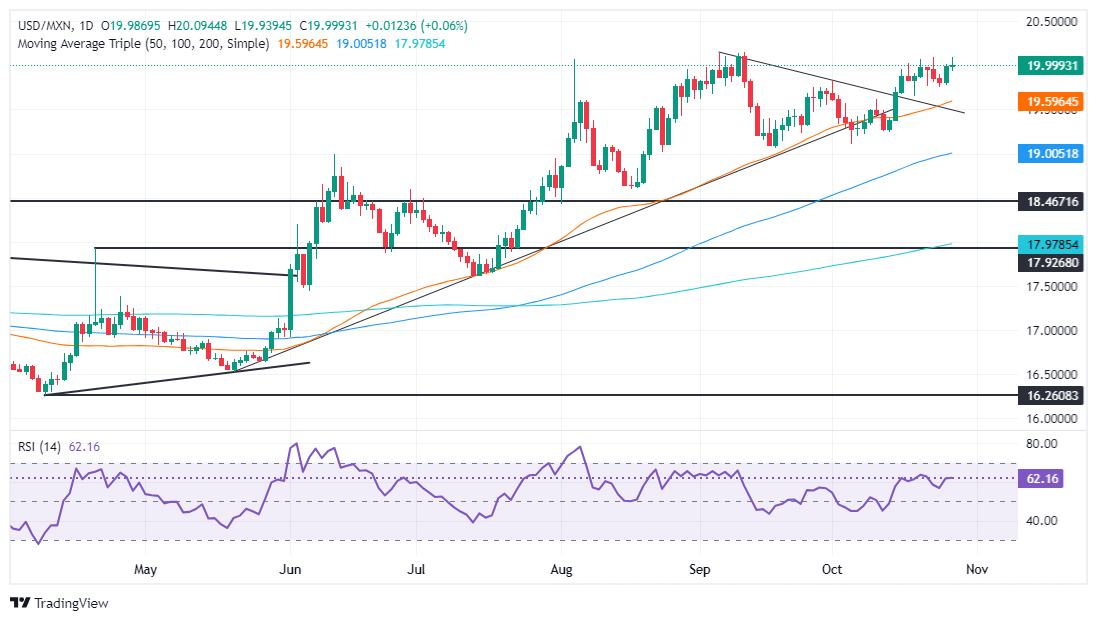Mexican Peso slumps past 20.00 fazed by economic slowdown, US election

- Mexican Peso pressured as Trump’s chances in the US election rise.
- Mexico’s recent economic data shows ongoing slowdown with weak Retail Sales and Economic Activity suggesting possible Banxico rate cuts.
- This week’s focus includes Mexico’s Q3 GDP, while US data releases will feature GDP, jobs data, and inflation figures.
The Mexican Peso depreciates against the US Dollar on Monday, extending its losses past the psychological 20.00 figure. The Peso is being undermined by fears of former President Donald Trump’s victory in the US election on November 5, while a tranche of Mexico’s economic data last week suggests the economy is decelerating. The USD/MXN trades at 20.02, up 0.41%.
In 2016, Donald Trump won the election, which boosted the USD/MXN from 18.60 to 20.90. However, that was just the first leg. The rally extended to 22.00 after Trump took office in January 2017. A victory for the former US President would imply imposing tariffs on Mexican imports and restrictive immigration policies, which could hurt the Mexican currency.
Polling site FiveThirtyEight shows that Trump’s odds of winning the US election have risen to 52%, against 48% for Vice President Kamala Harris. Nevertheless, the Democratic nominee remains marginally ahead in most national polls.
Bloomberg Economics reported on an analysis made last month that US federal debt may rise to 116% of Gross Domestic Product (GDP) under Trump’s tax-cut plan. Under Harris’s platform, it would be on a path to 109%.
Mexico’s Retail Sales and Economic Activity data for August were weaker than expected last week, according to INEGI. This, along with a goodish mid-month inflation report in October, could open the door for another interest rate cut by the Bank of Mexico (Banxico) at the upcoming November meeting.
The swaps market suggests Banxico will cut between 175 to 200 basis points over the next 12 months. Mexico’s central bank is expected to lower rates to 10.25% for the upcoming meeting.
Ahead of the week, Mexico’s economic schedule will feature the release of Gross Domestic Product (GDP) figures for Q3 2024, Business Confidence, and S&P Global Manufacturing PMI.
In the US, the economic docket is expected to reveal jobs data, GDP for the third quarter of 2024 on its preliminary reading, the Fed’s preferred inflation gauge, the Core Personal Consumption Expenditures (PCE) Price Index and Nonfarm Payrolls (NFP).
Daily digest market movers: Mexican Peso on the backfoot ahead of busy Mexico-US docket
- Mexico’s GDP in Q2 came at 0.2% QoQ and 2.1% YoY. If GDP for the third quarter, on a quarterly and annual basis, misses those marks, it could mean that the economy might be tipped into a recession.
- On Tuesday, the US economic docket will feature US JOLTS for September, which are expected to drop from 8.04 million to 7.99 million.
- At the same time, the Conference Board (CB) is expected to release October’s Consumer Confidence reading, which is likely to improve from 98.7 to 99.3.
- The US Bureau of Economic Analysis will reveal the GDP for the third quarter on Wednesday. Estimates suggest the economy grew 3% QoQ.
- Data from the Chicago Board of Trade, via the December fed funds rate futures contract, shows investors estimate 49 bps of Fed easing by the end of the year.
USD/MXN technical outlook: Mexican Peso tumbles as USD/MXN closes into 20.00
The USD/MXN uptrend remains intact despite consolidating near 19.70/20.00 for the last six days. Momentum remains bullish as the Relative Strength Index (RSI) depicts. This means the pair could challenge year-to-date (YTD) peaks as we get closer to November 5, US election day.
If buyers clear the 20.00 figure, they could test the last week peak at 20.09. On further strength, the USD/MXN could aim toward the YTD high at 20.22, ahead of key psychological levels of 20.50 and 21.00.
On the other hand, if sellers reclaim the October 18 low at 19.64, this could pave the way for a challenge to 19.50. The next move would be toward the October 4 swing low of 19.10 before testing 19.00.
Mexican Peso FAQs
The Mexican Peso (MXN) is the most traded currency among its Latin American peers. Its value is broadly determined by the performance of the Mexican economy, the country’s central bank’s policy, the amount of foreign investment in the country and even the levels of remittances sent by Mexicans who live abroad, particularly in the United States. Geopolitical trends can also move MXN: for example, the process of nearshoring – or the decision by some firms to relocate manufacturing capacity and supply chains closer to their home countries – is also seen as a catalyst for the Mexican currency as the country is considered a key manufacturing hub in the American continent. Another catalyst for MXN is Oil prices as Mexico is a key exporter of the commodity.
The main objective of Mexico’s central bank, also known as Banxico, is to maintain inflation at low and stable levels (at or close to its target of 3%, the midpoint in a tolerance band of between 2% and 4%). To this end, the bank sets an appropriate level of interest rates. When inflation is too high, Banxico will attempt to tame it by raising interest rates, making it more expensive for households and businesses to borrow money, thus cooling demand and the overall economy. Higher interest rates are generally positive for the Mexican Peso (MXN) as they lead to higher yields, making the country a more attractive place for investors. On the contrary, lower interest rates tend to weaken MXN.
Macroeconomic data releases are key to assess the state of the economy and can have an impact on the Mexican Peso (MXN) valuation. A strong Mexican economy, based on high economic growth, low unemployment and high confidence is good for MXN. Not only does it attract more foreign investment but it may encourage the Bank of Mexico (Banxico) to increase interest rates, particularly if this strength comes together with elevated inflation. However, if economic data is weak, MXN is likely to depreciate.
As an emerging-market currency, the Mexican Peso (MXN) tends to strive during risk-on periods, or when investors perceive that broader market risks are low and thus are eager to engage with investments that carry a higher risk. Conversely, MXN tends to weaken at times of market turbulence or economic uncertainty as investors tend to sell higher-risk assets and flee to the more-stable safe havens.
Information on these pages contains forward-looking statements that involve risks and uncertainties. Markets and instruments profiled on this page are for informational purposes only and should not in any way come across as a recommendation to buy or sell in these assets. You should do your own thorough research before making any investment decisions. FXStreet does not in any way guarantee that this information is free from mistakes, errors, or material misstatements. It also does not guarantee that this information is of a timely nature. Investing in Open Markets involves a great deal of risk, including the loss of all or a portion of your investment, as well as emotional distress. All risks, losses and costs associated with investing, including total loss of principal, are your responsibility. The views and opinions expressed in this article are those of the authors and do not necessarily reflect the official policy or position of FXStreet nor its advertisers. The author will not be held responsible for information that is found at the end of links posted on this page.
If not otherwise explicitly mentioned in the body of the article, at the time of writing, the author has no position in any stock mentioned in this article and no business relationship with any company mentioned. The author has not received compensation for writing this article, other than from FXStreet.
FXStreet and the author do not provide personalized recommendations. The author makes no representations as to the accuracy, completeness, or suitability of this information. FXStreet and the author will not be liable for any errors, omissions or any losses, injuries or damages arising from this information and its display or use. Errors and omissions excepted.
The author and FXStreet are not registered investment advisors and nothing in this article is intended to be investment advice.




